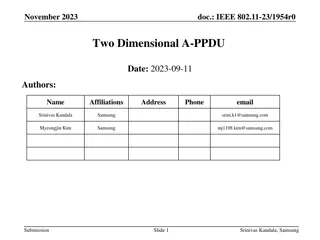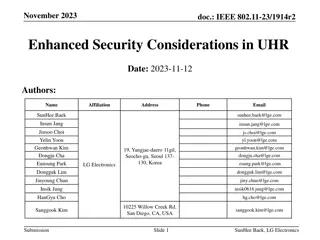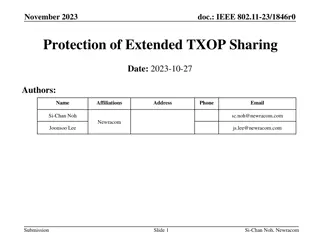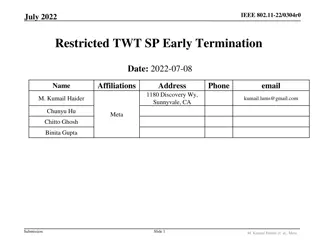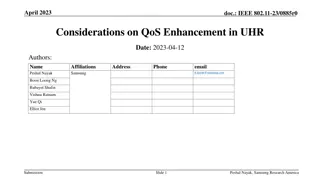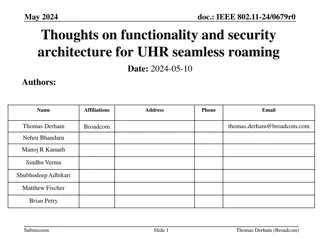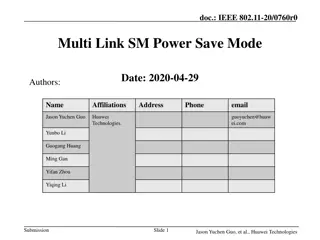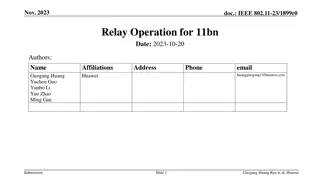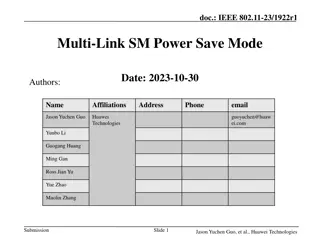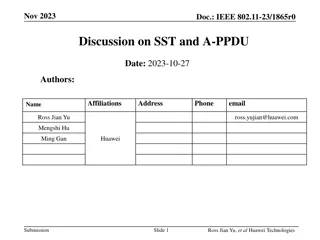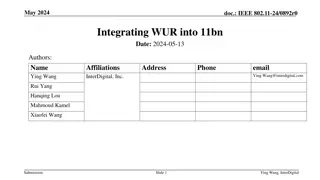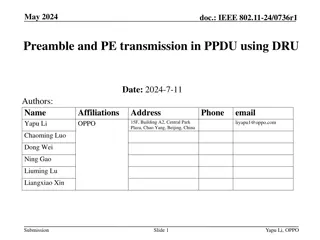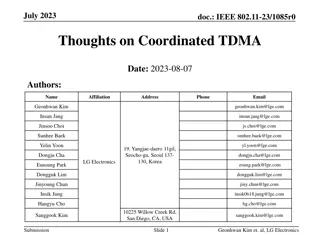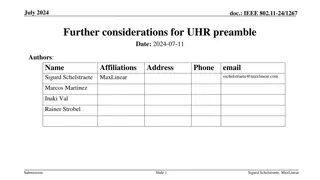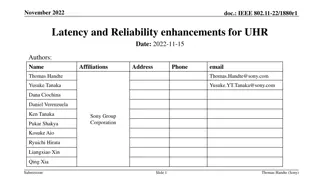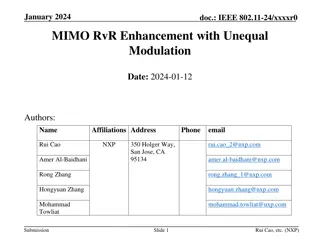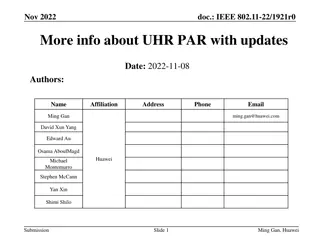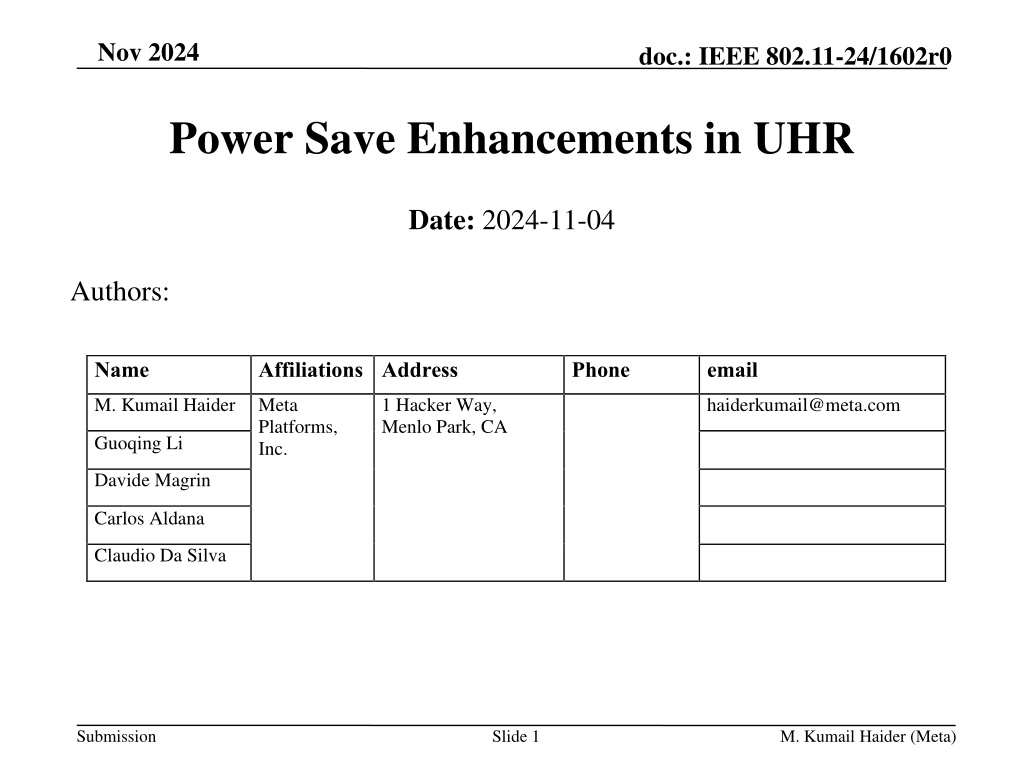
Power Save Enhancements in IEEE 802.11-24 for UHR Devices
Explore power saving enhancements in IEEE 802.11-24 for Ultra High Rate devices like Mobile APs and Infra APs. Address issues related to disruption of low latency applications, unpredictability in availability, and the need for explicit signaling methods for uninterrupted operations.
Download Presentation

Please find below an Image/Link to download the presentation.
The content on the website is provided AS IS for your information and personal use only. It may not be sold, licensed, or shared on other websites without obtaining consent from the author. Download presentation by click this link. If you encounter any issues during the download, it is possible that the publisher has removed the file from their server.
E N D
Presentation Transcript
Nov 2024 doc.: IEEE 802.11-24/1602r0 Power Save Enhancements in UHR Date: 2024-11-04 Authors: Name Affiliations Address Phone email M. Kumail Haider Meta Platforms, Inc. 1 Hacker Way, Menlo Park, CA haiderkumail@meta.com Guoqing Li Davide Magrin Carlos Aldana Claudio Da Silva Submission Slide 1 M. Kumail Haider (Meta)
Nov 2024 doc.: IEEE 802.11-24/1602r0 Background and Motivation AP Power save Mobile APs (Soft APs, Hotspots etc.) are typically power constrained/battery operated devices that employ different mechanisms for power saving TGbn is discussing enhancements to these mechanisms and possibly introducing new mechanisms [1-6] Expanding power saving methods to regular/Infra APs is also under discussion AP/Mobile AP power saving schemes fall into two broad categories Scheduled mechanisms: Mobile AP becomes unavailable at periodic intervals which are announced in advance to associated STAs. E.g., B-TWT with Responder PM which is already in use by some technologies. Unscheduled mechanisms: AP/Mobile AP is in lower power mode with reduced capabilities (NSS/BW/#links) and requires some ICF to switch to higher power mode/full capability Submission Slide 2 M. Kumail Haider (Meta)
Nov 2024 doc.: IEEE 802.11-24/1602r0 Problem Statement AP/Mobile AP power save operation can be hugely disruptive for low latency applications at STAs if not managed properly Issues already observed in the field: Mobile APs doing unscheduled power save introduces unpredictability in their availability as STAs expect APs to be always available and with full capabilities Even with scheduled power save schemes, Mobile APs may not always inquire/consider STA requirements when devising their own schedules It is hard for STAs to manage their own power save operation while dealing with unpredictable availability of Mobile APs, may lead to higher power consumption for STAs and longer latency for applications Mobile APs may introduce unavailability periods or enter into power saving operation while a low latency application is running (STA did not get heads up at association) As we discuss extending power saving mechanisms to infra APs, the problem is expected to become more widespread if not addressed properly Explicit signaling methods for STAs to request guaranteed availability of APs are crucial for uninterrupted low latency applications support Submission Slide 3 M. Kumail Haider (Meta)
Nov 2024 doc.: IEEE 802.11-24/1602r0 Existing Solutions and Frameworks (1) TWT for guaranteed availability STA may setup TWT (individual/broadcast/restricted TWT) schedules with an AP/Mobile AP for guaranteed availability of AP/Mobile AP during TWT SPs. However, setting up TWT may not always be possible and/or desirable: TWT may not be supported by some Mobile APs and/or STAs, hence it is not the ideal solution for each use case STA may just need a guaranteed availability from AP/Mobile AP without setting up additional commitments (STA wake schedules, wake durations and frame exchange requirements) that come with TWT Submission Slide 4 M. Kumail Haider (Meta)
Nov 2024 doc.: IEEE 802.11-24/1602r0 Existing Solutions and Frameworks (2) SCS procedures with QoS IE In 802.11be we expanded SCS procedures to include QoS Characteristics element, which can indicate service intervals and traffic requirements etc. SCS procedure requires that AP should service the STAs in DL within specified service intervals and facilitate UL traffic delivery. Missing aspects: 1. No shall behavior for guaranteed availability of APs during these intervals is defined in EHT SCS procedures. 2. Service intervals may not always translate into a fixed availability schedule (Min/max service intervals and no fixed interval duration) 3. AP availability adds another layer of operational details that need to be explicitly negotiated during SCS procedures Submission Slide 5 M. Kumail Haider (Meta)
Nov 2024 doc.: IEEE 802.11-24/1602r0 Proposal: Enhancing QoS IE for AP Availability indication AP Availability indication in QoS IE Exact field name is TBD One of the reserved bits in the Control Info field could be used Mechanism could be used with UL and/or DL directions Min/Max Service Intervals should be set to the same value for this use case Service Start Time field should also be specified Optionally indicate specific LinkID if availability is requested on a particular link (LinkID is currently reserved for DL/UL directions) If SCS procedure is successful with AP Availability indication, AP/Mobile AP shall be available at the specified service intervals Use one of the reserved bits Submission Slide 6 M. Kumail Haider (Meta)
Nov 2024 doc.: IEEE 802.11-24/1602r0 Some further thoughts Additional signaling framework for AP Availability STA may not always be looking to setup an SCS for requesting AP availability New containers/frames may be defined for carrying QoS Char element for the specific purpose of requesting AP availability Direction/TID/UP fields may be reserved Other fields, not relevant to service interval definition, may also be reserved when QoS IE is carried in the new frame to simplify negotiation procedure Submission Slide 7 M. Kumail Haider (Meta)
Nov 2024 doc.: IEEE 802.11-24/1602r0 Summary We discuss issues resulting in disruption of low latency applications when STAs operate with mobile APs doing power saving operations As TGbn is discussing expanding AP power save and extending to regular/infra APs, the problem is expected to worsen We evaluate existing signaling/frameworks and make recommendations for enhancements to ensure low latency applications at STAs are not disrupted, or STAs get a heads up before setting up services We also propose to add AP availability indication to QoS characteristics element for STAs to request guaranteed availability of APs during indicated service intervals Submission M. Kumail Haider (Meta) Slide 8
Nov 2024 doc.: IEEE 802.11-24/1602r0 References [1] 24/1502, Discussion on AP Power Save [2] 24/450, A Proposal for UHR Soft-AP Power Save [3] 24/659, Thoughts on AP Power Save [4] 24/813, Discussions on AP Power Save [5] 24/671, Enhancements on AP Power Save [6] 23/2040, Enabling AP power save_follow up Submission M. Kumail Haider (Meta) Slide 9
Nov 2024 doc.: IEEE 802.11-24/1602r0 SP1 Do you agree add the following text to TGbn SFD: TGbn defines a mechanism that enables a STA to request guaranteed availability from AP/Mobile AP during certain time periods NOTE 1 The exact signaling mechanism is TBD NOTE 2 It is AP s discretion to accept the request or not Submission M. Kumail Haider (Meta) Slide 10


